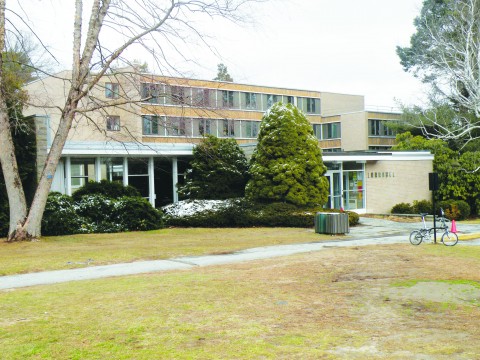 The number of campus renewal projects actualized this past summer reminds us that the College is hard at work, even when we’re on break.
The number of campus renewal projects actualized this past summer reminds us that the College is hard at work, even when we’re on break.
“It gets quite busy in here during the summer while you guys are out,” said Jim Norton, the Director of Physical Plant, who monitored the construction for more than three months. This summer’s renovations are part of a 10-year renewal plan, incorporated into Conn’s Centennial Celebrations, and have ignited an ongoing debate among the student body.
From the day after Commencement until Convocation, carpenters, plumbers, electricians, roofers and painters teamed up to take over a hundred carefully planned summer projects to completion. According to Vice President of Administration Ulysses Hammond, the largest projects are the addition of two new classrooms and a new digital photo imaging studio at the Cumming Arts Center, the renovation of Larrabee, Abbey and Lazrus’ bathrooms, the installation of a more energy efficient cooling system in the Shain Library, the refurbishment of Charles Chu Reading Room and the creation of Winchester student housing.
However, the renovations are not limited to those highlighted by the college: basement room lighting improvement, steam leak repairs and road resurfacing also add to the list of summer work. Norton explained that a college database contains a list of up to 2,000 projects that need to be put in place. Due to budget constraints and priority issues, like safety and practicality, however, only about 100 of these projects actually make it into each summer’s renewal plans. Deciding what gets done and what waits is a long process that starts in September and continues until students leave in the spring, which is when the changes start getting actualized.
This summer, 105 projects were completed at a cost of $3.8 million.
Student reactions to the campus renewal are mixed, ranging from those who cheerfully welcome the work done to those who have not paid notice at all.
SGA President Nathan Cornell ’11 witnessed the renovations firsthand over the summer. “Our campus is always beautiful, but in my almost four years here, Connecticut College has never looked this great,” he said. “This sentiment is not only shared among students, but also faculty and staff who have been part of this community long before our time—the campus is sparkling.”
As the Housefellow of Larrabee, a dorm that went through extensive repairs, Adam Miller ‘11 said, “It looks a lot better, and I haven’t heard any complaints from the students.”
Alumnus Brian Oduor ’06 was astonished with the campus’ beautification, calling the changes remarkable. “Compared to what it was like when I went here, the campus looks absolutely stunning.”
While some members of the college community appreciate the renovations, many students share a rather critical view, perceiving the renovations to be largely insignificant.
“Unimpressed” was junior Ron Birnkrant’s blunt response when asked about the changes. Nate Goldman ’11 found the new doors in front of Cro “wasteful.”
On the more extreme end, some students were totally unaware that the campus had undergone any changes.
When asked if he liked the new renovations on campus, one senior student replied, “I really haven’t noticed anything new.” Said another, “Which changes? I haven’t noticed anything at all.”
Indeed, the renovations bring up a point of contention regarding how resources are being allocated, and whether it correlates to the real needs of students at the college. A general sense of divergence between college spending and student concerns was voiced by many members of the student body.
“It’s about priorities,” says Celia Whitehead ’11. “The administration is worried about the outside look of our campus in order to attract new students, but huge gaps still remain in the college’s programs that current students are part of.”
Although the Tempel Green outdoor classroom was funded by a donation to the college, it still falls at the center of the debate, as it has come to symbolize the contradictions that some students see in the college’s development planning.
“I am aware that many students pay a lot for to this college, but I am not sure to what extent we are benefiting from the outdoor classroom,” a senior said.
In spite of the current debate, the renovations seem to have no stop with the Centennial at the doorstep. President Higdon’s formal announcement of the Harkness café project epitomizes the college’s seemingly fixed focus on infrastructure building for the years to come. This focus promises more student-driven discussion about the relevance of the campus renovations. Whether or not it will have any significant impact on the college’s current trend remains to be seen.









Great post! Very good writing.
Excellent post. I’ll back here soon.
Interesting post. You’re very good writer.